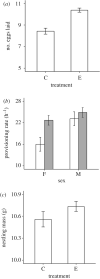Experimentally induced increases in fecundity lead to greater nestling care in blue tits
- PMID: 31238840
- PMCID: PMC6599988
- DOI: 10.1098/rspb.2019.1013
Experimentally induced increases in fecundity lead to greater nestling care in blue tits
Abstract
Models on the evolution of bi-parental care typically assume that maternal investment in offspring production is fixed and predict subsequent contributions to offspring care by the pair are stabilized by partial compensation. While experimental tests of this prediction are supportive, exceptions are commonplace. Using wild blue tits ( Cyanistes caeruleus), we provide, to our knowledge, the first investigation into the effects of increasing maternal investment in offspring production for subsequent contributions to nestling provisioning by mothers and male partners. Females that were induced to lay two extra eggs provisioned nestlings 43% more frequently than controls, despite clutch size being made comparable between treatment groups at the onset of incubation. Further, experimental males did not significantly reduce provisioning rates as expected by partial compensation, and if anything contributed slightly (9%) more than controls. Finally, nestlings were significantly heavier in experimental nests compared with controls, suggesting that the 22% average increase in provisioning rates by experimental pairs was beneficial. Our results have potential implications for our understanding of provisioning rules, the maintenance of bi-parental care and the timescale over which current-future life-history trade-offs operate. We recommend greater consideration of female investment at the egg stage to more fully understand the evolutionary dynamics of bi-parental care.
Keywords: current–future trade-offs; life-history theory; matching; provisioning rules; quality-quantity trade-offs; residual reproductive value.
Conflict of interest statement
We have no competing interests.
Figures

References
-
- Royle NJ, Smiseth PT, Kölliker M. 2012. The evolution of parental care. Oxford, UK: Oxford University Press.
-
- Williams GC. 1966. Natural selection, the costs of reproduction, and a refinement of Lack's principle. Am. Nat. 100, 687–690. (10.1086/282461) - DOI
-
- Trivers R. 1972. Parental investment and sexual selection. In Sexual selection and the descent of man 1871–1971 (ed. Campbell B.), pp. 136–208. Chicago, IL: Aldine Transaction.
-
- Houston A, Davies NB. 1985. The evolution of co-operation and life history in the dunnock, Prunella modularis. In Behavioural ecology: ecological consequences of adaptive behaviour (eds Sibly RM, Smith RH), pp. 471–487. Oxford, UK: Blackwell.
Publication types
MeSH terms
Associated data
LinkOut - more resources
Full Text Sources

